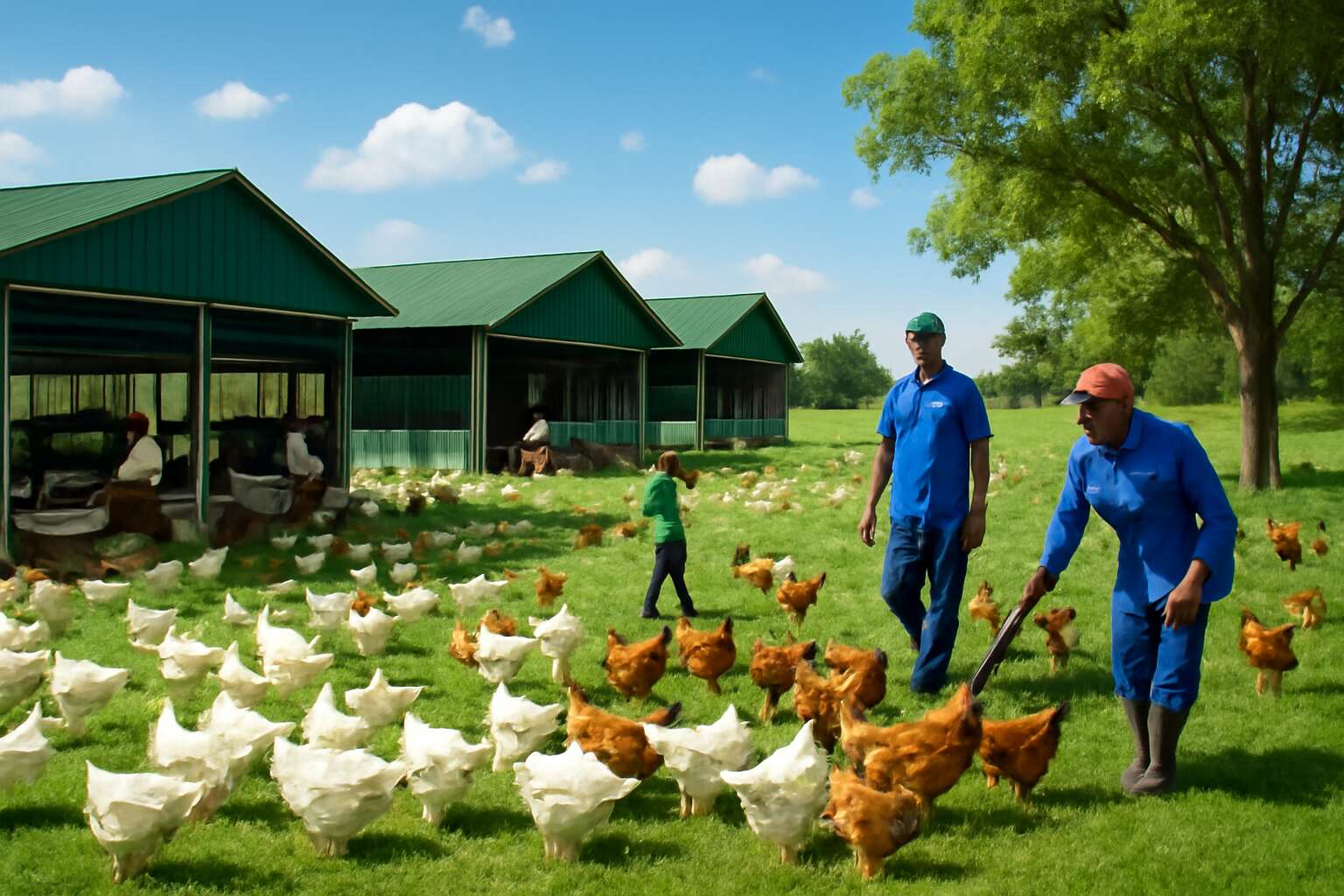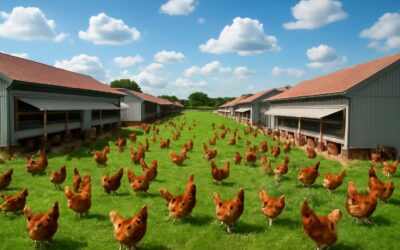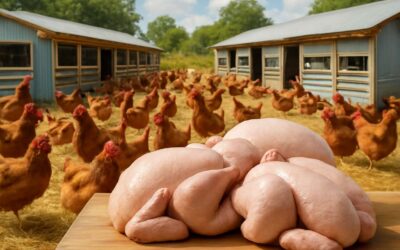Overview of Poultry Farming in Brits
Types of Poultry Farms Commonly Found in Brits – Broiler farms, layer farms, organic poultry farms
In the fertile plains surrounding Brits, a vibrant tapestry of poultry farming unfolds—each farm a vital thread in the fabric of local agriculture. These poultry farms in Brits are not mere enterprises; they are the heartbeat of a community, pulsing with life and purpose. From dawn’s first light, the gentle clucking of hens and the rhythmic stride of broilers echo through the air, a symphony of industry and nature intertwined.
Among the most prevalent types of poultry farms in Brits are the broiler farms, dedicated to raising chickens for meat. These farms focus on rapid growth and efficiency, transforming hatchlings into succulent poultry in a matter of weeks. Equally significant are the layer farms, where hens lay the eggs that feed homes and markets, their delicate productivity a dance of patience and care. Organic poultry farms, on the other hand, stand as a testament to sustainable practices, prioritising natural diets and humane treatment, offering consumers a wholesome choice amid the bustling poultry landscape of Brits.
History and Development of Poultry Farming in Brits – Evolution over recent years, key milestones
The chronicles of poultry farming in Brits are etched with tales of resilience and transformation, echoing through the fertile plains like whispers from a bygone era. Once, simple rural pursuits sustained communities, but over the years, poultry farm in Brits has evolved into a sophisticated dance of innovation and tradition. The journey from rudimentary coops to modern facilities reflects a deepening understanding of poultry biology and husbandry, driven by a relentless pursuit of efficiency and sustainability.
Key milestones mark this evolution: technological advancements, improved genetic strains, and a shift towards organic practices have all reshaped the landscape. Today, the poultry farm in Brits stands as a testament to both heritage and progress, blending age-old reverence for the land with cutting-edge techniques. As the industry continues to develop, the heartbeat of these farms pulses stronger, embodying a legacy that is both darkly poetic and fiercely resilient.
Location and Environment of Poultry Farms in Brits
Ideal Locations for Poultry Farms – Accessibility, climate considerations, proximity to markets
In the heart of Brits, the success of a poultry farm hinges not only on the quality of the birds but equally on the location and environment. An ideal poultry farm in Brits is nestled within accessible yet discreet areas, where the landscape fosters healthy growth while minimising disruptions. Accessibility to main roads and nearby markets ensures that produce reaches consumers swiftly, preserving freshness and quality. Moreover, the climate plays a pivotal role—moderate temperatures with minimal fluctuations provide a natural advantage, reducing stress on the poultry and cutting down on energy costs for climate control.
Proximity to essential resources such as water sources and feed suppliers is paramount. A poultry farm in Brits benefits greatly from being situated in regions where the environment supports biosecurity measures, decreasing the risk of disease. The local terrain should be well-drained, preventing waterlogging that could compromise bird health. Ultimately, selecting a location that balances accessibility with environmental stability creates a sustainable foundation for poultry farming success—one where nature and human ingenuity intertwine seamlessly.
Environmental Impact and Sustainability – Efforts in eco-friendly farming, waste management practices
In the pursuit of sustainable poultry farming, the choice of location is paramount—more than just a strategic decision, it’s a commitment to harmony with nature. A poultry farm in Brits that champions eco-friendly practices does so by meticulously selecting a site that minimises environmental impact, weaving ecological integrity into its very foundation. Such farms often embrace waste management practices that transform potential pollutants into valuable resources, reducing pollution and fostering a cycle of renewal.
Efforts to reduce the carbon footprint are evident in initiatives like composting poultry litter for fertiliser or utilising renewable energy sources. These endeavours are not mere trends but vital components of responsible farming, ensuring the land remains fertile and resilient for generations to come. When environmental impact is prioritised, the farm’s footprint becomes a testament to modern sustainability—proof that productivity and ecological stewardship can coexist in a flourishing symbiosis.
Infrastructure and Facilities in Poultry Farms
Building Structures and Housing – Design of coops, ventilation, lighting
Within the realm of a thriving poultry farm in Brits, the infrastructure and facilities form the backbone of a seamless operation. The architectural design of coops must harmonise with nature’s rhythm, ensuring optimal comfort and productivity for the poultry. Thoughtfully crafted ventilation systems breathe life into these structures, maintaining a gentle flow of fresh air that wards off the stifling heat and humidity often found in warmer seasons. Lighting, both natural and artificial, is meticulously calibrated to mimic day-night cycles, fostering healthy growth and egg production.
Building structures are often tailored to withstand the unpredictable British climate, with robust materials and effective insulation. This resilient design not only safeguards the poultry but also enhances energy efficiency. The layout of these facilities often includes a combination of open-sided sheds and enclosed spaces, each serving distinct functions within the poultry farm in Brits. Such strategic planning ensures that every bird receives the ideal environment to flourish, reflecting a commitment to sustainable and humane farming practices.
Feeding and Watering Systems – Automated feeders, water supply systems
At the heart of a successful poultry farm in Brits lies the meticulous design of feeding and watering systems, integral to maintaining healthy, productive flocks. Automated feeders have revolutionised poultry farming by ensuring consistent and precise distribution of feed, reducing waste and labour costs. These systems can be tailored to the specific nutritional needs of different poultry breeds, promoting optimal growth and egg production.
Complementing the feeders, reliable water supply systems are vital. Modern poultry farms in Brits utilise advanced watering mechanisms such as nipple drinkers and automatic troughs, which deliver clean, fresh water directly to each bird. This reduces contamination risks and encourages consistent hydration, crucial during the warmer months when dehydration can impair poultry health.
Efficient infrastructure extends beyond feeding to include seamless water management. Some farms incorporate rainwater harvesting or specialised water filtration systems to ensure sustainability and reduce operational costs. Whether housed in open-sided sheds or enclosed structures, a poultry farm in Brits relies heavily on these integrated systems to optimise productivity and animal welfare—key pillars of sustainable, modern poultry farming.
Biosecurity Measures – Fencing, disinfection protocols, access controls
Ensuring the health and safety of poultry in a bustling poultry farm in Brits requires a fortress of robust biosecurity measures. Fencing acts as the first line of defence, creating a secure perimeter that keeps unwanted visitors and predators at bay. High-quality, durable fencing materials form an invisible shield, safeguarding flocks from external threats and preventing disease transmission.
Disinfection protocols are the backbone of disease prevention. Regularly sanitising equipment, footwear, and even the farm’s entry points significantly reduces the risk of contamination. Access controls further enhance security; strict entry policies limit access to authorised personnel only, helping to maintain a clean environment.
To optimise biosecurity, many farms incorporate a layered approach:
- Dedicated footwear stations at entry points
- Restricted zones within the farm
- Visitor logbooks for tracking movement
These measures create a vigilant environment where the health of every bird is safeguarded with precision and care. In a poultry farm in Brits, such comprehensive biosecurity protocols are vital for fostering sustainable, disease-resistant poultry production, ensuring the farm’s longevity and profitability.
Poultry Farming Practices in Brits
Breeding and Selection – Choice of breeds, genetic improvements
Poultry farming in Brits is more than just a tradition — it’s a carefully cultivated science. The choice of breeds plays a pivotal role in ensuring farm productivity and resilience. Breeders in Brits often prioritise genetic improvements that boost growth rates, egg production, and disease resistance, transforming poultry farms into efficient, high-yield operations. Selecting the right breed isn’t merely about preference; it’s about aligning genetics with environmental conditions and market demands.
Innovative breeding programmes in Brits have embraced modern genetics, focusing on traits that enhance feed conversion ratios and overall robustness. This meticulous breeding process involves a combination of traditional selection and cutting-edge genetic techniques. For instance, breeders often select for high-producing layers that thrive in local climate conditions, securing a steady supply of eggs. Such careful choices underpin the success of poultry farms in Brits, ensuring sustainability and profitability in a competitive market.
Feeding Regimens – Nutrition plans, feed quality
In the intricate dance of poultry farming in Brits, nutrition regimens are not mere routines but carefully calibrated symphonies designed to optimise flock health and productivity. A well-designed feeding programme hinges on the quality of feed and precise nutritional balance, ensuring birds reach their full potential without unnecessary waste. High-quality feed, rich in essential amino acids, vitamins, and minerals, forms the backbone of a thriving poultry farm in Brits. It’s a delicate balance that influences everything from growth rates to egg production, making every pellet and mash count.
To maximise efficiency, many poultry farms in Brits employ advanced feeding systems—automated feeders that deliver precise quantities at optimal times. These innovations minimize labour while ensuring consistency, which is vital for maintaining the health and vigour of the flock. Hydration, equally crucial, is supported through reliable water supply systems that promote continuous access, preventing dehydration-related setbacks. When combined, these practices create an environment where poultry can flourish, driven by optimal nutrition and meticulous management.
Furthermore, the importance of tailored nutrition plans cannot be overstated. Farms often utilise a phased approach, adjusting feed compositions as birds mature—starting with starter feeds rich in protein, then progressing to grower and layer feeds with specific nutrient ratios. This strategic approach underscores the sophistication of poultry farm in Brits, where every element of feeding and watering systems is aligned to foster maximum yield and sustainability in a competitive industry.
Health and Disease Management – Vaccination schedules, parasite control
Maintaining a healthy flock on a poultry farm in Brits is no trivial task; it’s an intricate ballet of vigilance and precision. Vaccination schedules form the backbone of disease prevention, with immunisations tailored to thwart prevalent illnesses like Newcastle disease and avian influenza. These schedules are meticulously planned and executed, often integrated into the regular routines of the farm to ensure no bird is left unprotected.
Parasite control, another vital aspect, involves a combination of strategic measures such as regular deworming and the application of environmentally safe insecticides. Effective parasite management not only safeguards the health of the birds but also optimises growth rates and egg production. To streamline these efforts, some farms employ biosecurity measures like fencing, disinfection protocols, and controlled access points, creating a fortress against potential outbreaks.
In the bustling poultry farm in Brits, a layered approach is indispensable. Implementing a comprehensive vaccination schedule and vigilant parasite control regime ensures the flock remains resilient, thriving amidst the unpredictable whims of disease. It’s this unwavering dedication to health management that elevates a mere poultry operation into a model of sustainable, productive excellence.
Market and Economic Aspects of Poultry Farming in Brits
Supply Chain Dynamics – Distribution channels, partnerships
The vibrant poultry farm in Brits operates within a complex web of supply chain dynamics that are crucial to its success. Distribution channels serve as the arteries of this industry, connecting local farms to national markets and even international buyers. Efficient logistics ensure that fresh poultry and eggs reach consumers promptly, maintaining quality and taste. Partnerships with feed suppliers, veterinary services, and transportation companies are the backbone of smooth operations, fostering resilience amidst fluctuating market demands.
Market trends in Brits reveal a growing consumer appetite for organic and ethically farmed poultry, prompting farms to adapt swiftly. The integration of technology into distribution channels has revolutionised how poultry products are delivered, reducing lead times and wastage. The strategic positioning of the poultry farm in Brits—near major highways and urban centres—provides an advantageous edge, facilitating swift distribution and access to a broad customer base. As the poultry industry continues to evolve, maintaining solid partnerships and a keen understanding of market shifts remains essential for thriving within this competitive landscape.
Pricing and Profitability – Factors influencing market prices, profit margins
In the bustling heart of Brits, the economic pulse of poultry farming beats steadily, influenced by a mosaic of market forces and consumer preferences. Prices for poultry products are not arbitrary; they fluctuate based on feed costs, seasonal demand, and global market trends. A poultry farm in Brits must navigate these variables carefully to sustain profitability, especially as the industry shifts towards organic and ethically farmed poultry, which often commands a premium. Profit margins hinge on efficient production practices and strategic market positioning.
Market dynamics also shape the economic landscape for poultry farms in Brits. Local demand remains robust, yet exports and partnerships open additional revenue streams. Factors such as feed availability, labour costs, and government policies play pivotal roles in shaping the financial outlook. For instance, a poultry farm in Brits might experience profit margins that vary from 10% to 30%, depending on operational efficiencies and market conditions. Recognising these influences enables farmers to adapt swiftly and maintain resilience amidst fluctuating market prices.
- Market demand for organic poultry continues to grow, pushing farms to diversify and meet this niche.
- Input costs, especially for quality feed and veterinary supplies, directly impact overall profitability.
- Strategic pricing, aligned with consumer willingness to pay for ethically farmed poultry, can enhance margins.
Challenges Faced by Poultry Farmers – Market fluctuations, import competition
In the vibrant landscape of Brits, the poultry farm in Brits faces a delicate dance with market fluctuations that can swiftly shift the economic tide. Prices for poultry products are far from static; they ebb and flow with global feed costs, seasonal consumer demand, and international trade dynamics. This inherent volatility demands nimble strategies from farmers striving to maintain sustainable profit margins.
Amidst these challenges, import competition presents another formidable hurdle. Poultry farms in Brits often find themselves vying with imported poultry, which can undercut local prices and squeeze margins thin. The pressure to stay competitive while upholding quality standards, especially as organic and ethically farmed poultry carve out a growing niche, adds layers of complexity.
Market demand remains resilient, yet the unpredictability of export opportunities and fluctuating input costs—such as veterinary supplies and specialised feed—necessitate constant vigilance. Adapting to these volatile conditions is vital for anyone committed to thriving within the poultry farm in Brits ecosystem.
Regulations and Certifications for Poultry Farms in Brits
Government Policies and Standards – Health and safety regulations, animal welfare laws
Regulations and certifications are the backbone of sustainable and ethical poultry farming in Brits. The government enforces strict health and safety regulations to safeguard both workers and poultry health, ensuring that farms operate within safe parameters. Animal welfare laws are equally rigorous, mandating proper housing, access to clean water, and humane treatment standards. These policies foster a responsible environment where poultry are raised with dignity and care.
For a poultry farm in Brits to thrive, compliance with these standards is essential. Farms often seek certifications such as the *Poultry Welfare Certification* or *ISO standards*, which not only demonstrate adherence to legal requirements but also enhance market credibility. Regular inspections and audits ensure ongoing compliance and promote transparency in farming practices.
- Adherence to national health and safety regulations
- Implementation of animal welfare laws
- Obtaining relevant certifications for quality assurance
These measures help farms navigate the complex landscape of government policies and uphold the highest standards of ethical poultry farming in Brits.
Certification Programs – Organic certification, quality assurance labels
Certifications are the backbone of quality and trust in a poultry farm in Brits. They serve as proof that farms meet stringent standards for animal welfare, food safety, and environmental sustainability. Organic certification, for example, guarantees that poultry are raised without synthetic additives or antibiotics, appealing to health-conscious consumers. This label is increasingly sought after and can significantly boost market credibility.
In addition, quality assurance labels like the Red Tractor or GlobalG.A.P. demonstrate compliance with rigorous safety and welfare standards. Farms often pursue these certifications to differentiate themselves in a competitive market. They also help farms access broader distribution channels and premium markets.
Regular audits and inspections are crucial to maintain these certifications. They ensure that the poultry farm in Brits aligns with evolving regulations and consumer expectations. For farm operators, obtaining and upholding these standards isn’t just about legality—it’s about building long-term trust with customers and stakeholders.
Compliance and Documentation – Inspections, record-keeping
Regulatory compliance is the silent backbone of a reputable poultry farm in Brits, anchoring trust through meticulous documentation and rigorous inspections. It’s not merely about adhering to rules; it’s a moral commitment to animal welfare, food safety, and environmental stewardship. Every farm must keep detailed records of vaccination schedules, feed quality, and biosecurity measures—these logs are the farm’s moral ledger, demonstrating accountability and transparency in an industry fraught with moral dilemmas.
Inspections by regulatory authorities ensure that standards are upheld consistently, fostering a culture of continuous improvement. These audits scrutinise every facet of farm operation—from housing conditions to waste management practices—ensuring compliance with both national policies and international standards. For a poultry farm in Brits, this process is an ongoing dialogue with regulators, a testament to the farm’s dedication to ethical farming.
- Accurate record-keeping
- Regular inspections
- Adherence to biosecurity protocols
- Compliance with environmental regulations
Such diligence isn’t just bureaucratic; it’s a reflection of the farm’s moral integrity. Ultimately, compliance and documentation forge the foundation upon which trust is built—trust that the poultry farm in Brits prioritises quality, safety, and sustainability over short-term gains, resonating deeply with consumers seeking authenticity in their food sources.
Innovations and Future Trends in Poultry Farming in Brits
Technological Advancements – Automation, data monitoring tools
In the shadowy corridors of modern agriculture, a silent revolution brews within the confines of a poultry farm in Brits. Technological advancements now weave a web of automation and data monitoring tools that whisper secrets of optimal production. These innovations are not merely conveniences but vital arteries that pulse through the heart of efficient poultry farming.
Automated feeding systems and climate control mechanisms have transformed the traditional farm into a symphony of precision, ensuring each bird receives tailored nourishment while maintaining ideal environmental conditions. Data monitoring tools track vital metrics—temperature, humidity, and feed consumption—allowing farmers to preempt health issues before they manifest into crises. Such technological prowess heralds a future where poultry farms in Brits can operate with unparalleled accuracy and sustainability.
As the curtain rises on this new era, the integration of these advancements promises not only increased profitability but also a profound shift towards eco-friendly practices—an essential step in safeguarding the fragile balance between agriculture and the environment. The future of poultry farming in Brits is undeniably intertwined with these innovations, forging a path into the unknown with a steady, unwavering gaze. Truly, the old ways are giving way to an era of enlightened farming—where machinery and instinct converge in the shadows of a poultry farm in Brits.
Sustainable Farming Initiatives – Alternative feeds, renewable energy use
As the horizon of poultry farming in Brits stretches towards a sustainable future, innovative practices are reshaping the industry’s landscape. One of the most promising developments is the shift toward eco-friendly farming initiatives that not only reduce environmental impact but also enhance productivity. For instance, alternative feeds—such as insect protein and plant-based options—are gaining traction, offering nutritious, sustainable choices that lessen reliance on traditional grain sources.
Simultaneously, renewable energy use is transforming poultry farms in Brits into models of green efficiency. Solar panels and biogas systems are increasingly common, powering operations while reducing carbon footprints. These initiatives are not just buzzwords; they are vital components of a resilient, future-proof poultry farm in Brits. Embracing these trends helps farmers navigate market fluctuations and meet evolving consumer demands for ethically produced poultry products.
Furthermore, integrating innovative feeding regimens and waste management systems ensures that poultry farms operate with optimal resource utilisation. By prioritising sustainability in every facet—from feed to energy—poultry farmers in Brits are setting new standards that balance profitability with ecological responsibility. The future of poultry farming here isn’t merely about production but about pioneering a harmonious coexistence with the environment, all while maintaining high-quality standards for poultry products.
Market Trends – Consumer preferences, export opportunities
Innovations in poultry farming are propelling the industry in Brits into a new era of technological marvels and eco-conscious practices. As consumer preferences shift towards ethically produced, sustainable poultry products, farms in Brits are embracing cutting-edge trends that harmonise profitability with environmental stewardship. The future of a poultry farm in Brits lies not only in traditional care but in pioneering advances that redefine the very essence of modern poultry production.
One of the most compelling future trends is the integration of smart technology—automated feeding and watering systems that optimise resource use while reducing waste. These innovations ensure that poultry farms in Brits operate with precision, enhancing bird health and productivity. Moreover, renewable energy solutions like solar panels and biogas plants are transforming farms into bastions of sustainability, significantly lowering carbon footprints and aligning with global ecological goals.
Market trends reveal that consumer demand for organic and ethically farmed poultry continues to grow exponentially. This shift opens lucrative export opportunities for poultry farms in Brits, especially as international markets seek high-quality, responsibly produced poultry products. Farms that adapt swiftly to these trends, leveraging advanced breeding and health management techniques, will stand at the forefront of this dynamic industry.
- Enhanced genetic selection and breeding techniques to produce resilient, high-yield poultry breeds.
- Adoption of eco-friendly waste management systems that convert farm by-products into valuable fertiliser or biogas.
- Implementation of traceability systems that assure consumers of the origin and quality of poultry products—crucial for building brand trust and expanding export reach.
As Brits’ poultry farms evolve, the confluence of technological innovation, sustainability, and market agility will cement their place in a future where poultry farming is not merely a livelihood but a testament to responsible, forward-thinking agriculture. The horizon gleams with promise, where each farm becomes a sanctuary of harmony between nature and enterprise, echoing the timeless rhythm of progress and purpose.




0 Comments